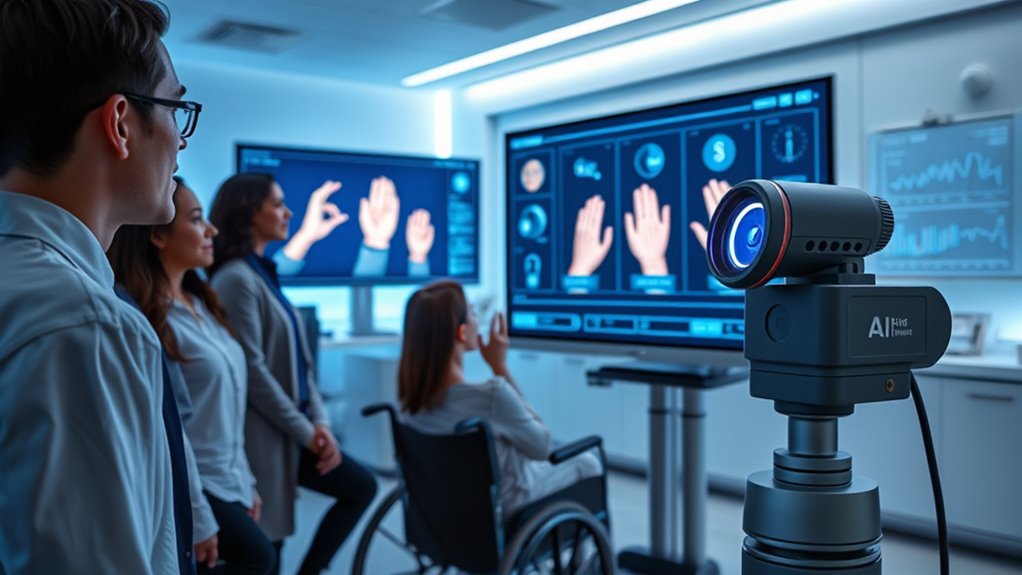Advancements in gesture datasets are profoundly boosting AI sign language recognition today. These datasets provide extensive, high-quality, diverse videos and images, helping AI understand subtle hand movements, facial expressions, and regional variations. As a result, real-time translation becomes more accurate and seamless, improving communication for users worldwide. Continuous improvements aim to make these systems more inclusive and reliable. If you’re curious about how technology is evolving further, there’s much more to explore.
Key Takeaways
- Sign language datasets are foundational for training AI systems to accurately recognize gestures, expressions, and movements.
- Advances in dataset diversity and quality have significantly improved real-time translation accuracy.
- Cutting-edge algorithms now handle complex gestures, facial cues, and environmental variations more effectively.
- Progress is driving more seamless, instant sign language interpretation for everyday, medical, and educational use.
- Ongoing developments aim to enhance inclusivity, bridging communication gaps and promoting accessible, real-time sign language AI tools.

AI Sign Language Recognition is transforming how we bridge communication gaps for the deaf and hard-of-hearing community. At the heart of this innovation are gesture datasets, which serve as the foundation for training AI systems to understand and interpret sign language accurately. These datasets consist of vast collections of labeled videos and images capturing a wide range of gestures, expressions, and movements used in different sign languages around the world. By analyzing these gesture datasets, machine learning models learn to recognize subtle hand movements, facial expressions, and body language, enabling more precise and reliable sign language interpretation. This process is essential because sign language is highly nuanced, with variations depending on regional dialects and individual signing styles. The better the gesture datasets, the more capable the AI becomes at understanding diverse users, making the technology more inclusive and effective.
Gesture datasets are vital for enabling AI to accurately interpret diverse sign language gestures worldwide.
As a user, you’ll notice that advancements in gesture datasets directly impact the quality of real-time translation. The goal is to enable seamless, immediate communication, allowing you to speak naturally without waiting for the AI to process and interpret each sign. Real-time translation is especially important in everyday conversations, medical consultations, educational settings, and public services, where instant understanding can profoundly improve accessibility. AI models trained on extensive gesture datasets can now process sign language instantly, converting it into spoken words or text with minimal delay. This immediacy helps bridge the gap between sign language users and those unfamiliar with it, fostering more spontaneous and meaningful interactions.
Furthermore, these improvements aren’t just about speed; they’re also about accuracy. The more diverse and extensive the gesture datasets, the better the AI system can handle complex signs and contextual nuances. The development of high-quality datasets ensures that AI systems can capture a wider range of signing styles and expressions, making translations more reliable across different users. The more diverse and extensive the gesture datasets, the better the AI system can handle complex signs and contextual nuances. The more comprehensive the datasets, the more robust the AI becomes at understanding subtle differences in gestures and facial cues. Achieving high accuracy in real-time translation also requires sophisticated algorithms that can adapt to different lighting conditions, backgrounds, and signing styles, making the technology more versatile and accessible across various environments.
Ultimately, as gesture datasets grow and improve, so does the potential for AI sign language recognition to become a truly inclusive tool. It’s not just about translating gestures; it’s about empowering you to communicate effortlessly and confidently, regardless of language barriers. With ongoing advancements, you’ll find that real-time translation becomes more reliable, intuitive, and integrated into everyday life, helping to create a world where everyone’s voice can be heard and understood.
Frequently Asked Questions
How Accurate Are Current AI Sign Language Recognition Systems?
You’ll find that current AI sign language recognition systems are quite accurate, especially with well-trained models. They analyze hand gestures effectively, but their accuracy can vary depending on the complexity of gestures and lighting conditions. Improving model robustness helps guarantee consistent performance across different environments and users. While not perfect, these systems are advancing rapidly, making communication easier for sign language users and bridging gaps in understanding.
What Are the Main Challenges in Real-Time Sign Language Translation?
You face challenges in real-time sign language translation due to gesture variability and hardware limitations. Gesture variability makes it hard for AI systems to accurately interpret different signers’ movements, while hardware constraints like camera quality or processing power can slow down or reduce accuracy. To improve, you need better sensors, more adaptable algorithms, and extensive training data that account for diverse signing styles.
How Do Different Sign Languages Affect AI Recognition Models?
Different sign languages markedly impact AI recognition models due to linguistic diversity and cultural nuances. You’ll find that models trained on one sign language often struggle with others because each has unique gestures, grammar, and context. To improve accuracy, you need diverse datasets that encompass these variations, allowing your model to adapt to different linguistic and cultural differences, ensuring more inclusive and effective sign language recognition.
What Privacy Concerns Exist With Sign Language Data Collection?
You should be aware that privacy concerns with sign language data collection include risks to data security and the need for informed consent. Without proper safeguards, sensitive information could be exposed or misused. Although some might argue data collection helps improve technology, ensuring your privacy rights are respected remains vital. You must advocate for transparent policies and secure data handling to protect your personal information and maintain trust in AI systems.
How Accessible Are AI Sign Language Tools Globally?
You’ll find that AI sign language tools are becoming more accessible globally, but their reach varies. In regions with strong technological infrastructure, adoption is rapid, supporting cultural diversity and inclusion. However, in areas with limited resources, adoption remains slow. To improve global adoption, developers need to take into account local languages and cultural nuances, ensuring these tools are inclusive and useful across diverse communities around the world.
Conclusion
As you explore AI sign language recognition, remember it’s a lighthouse guiding us through uncharted waters. With ongoing advancements, you’re on the brink of transforming communication for millions. Embrace the innovation, because this field is blossoming like a vibrant garden, promising a future where everyone connects effortlessly. Keep pushing boundaries, and you’ll be part of shaping a world where language barriers crumble like walls of glass, opening doors to endless possibilities.










